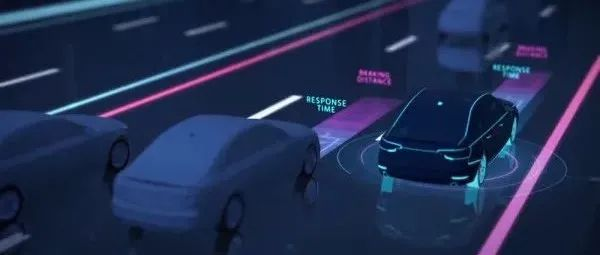Introduction
Human’s dream of autonomous driving began in the 1920s. General Motors (GM) can be said to be the pioneer of autonomous driving cars. In 1939, at the New York World’s Fair, its Futurama showcased the concept of future autonomous driving for the first time. However, it wasn’t until around 2015 that the automotive industry saw hope in realizing autonomous driving. By 2018, the industry in China had formed a consensus of combining artificial intelligence (AI) technology and smart cities, especially in smart transportation, to promote the real implementation of autonomous driving.
At the 2021 Zhongguancun Intelligent Connected Vehicle International Innovation Forum with the theme of “Intelligent Cars, Intelligent Driving, Smart Future,” Tong Lifeng, the general manager of Mobileye Greater China, shared some of Mobileye’s plans and new ideas for the automotive field.
The Fusion of Chips and Cars: A New Era
Tong Lifeng said that Mobileye’s development history in the field of autonomous driving for over 20 years is a microcosm of the integration of key technology for public transportation and digital management platforms in the automotive industry. From the early ADAS software and hardware to the current “explosive” growth of the autonomous driving industry, the entire industry has evolved from purely or simply technical and basic products into a new stage.
In this stage, the industry is thinking more about how autonomous driving and intelligent connected vehicle technology can help the development of the automotive and overall intelligent industries. How can these technologies be integrated into various applications in our daily travel process?
Back in 1999, Mobileye, which was established in Israel, had to “give eyes” to cars. As a software, algorithm, and chip technology company, it has been focusing on ADAS and autonomous driving solutions. Its vehicle and lane recognition rate based on vision system analysis and data processing can reach 99.99%.
Since 2012, Mobileye has expanded its organizational structure worldwide to promote business development in the automotive and travel fields around the world. At that time, Mobileye entered the Chinese market, established a professional team, and began early layout in ADAS technology and intelligent connected vehicle technology with traditional car manufacturers, including segmented transportation and travel fields.
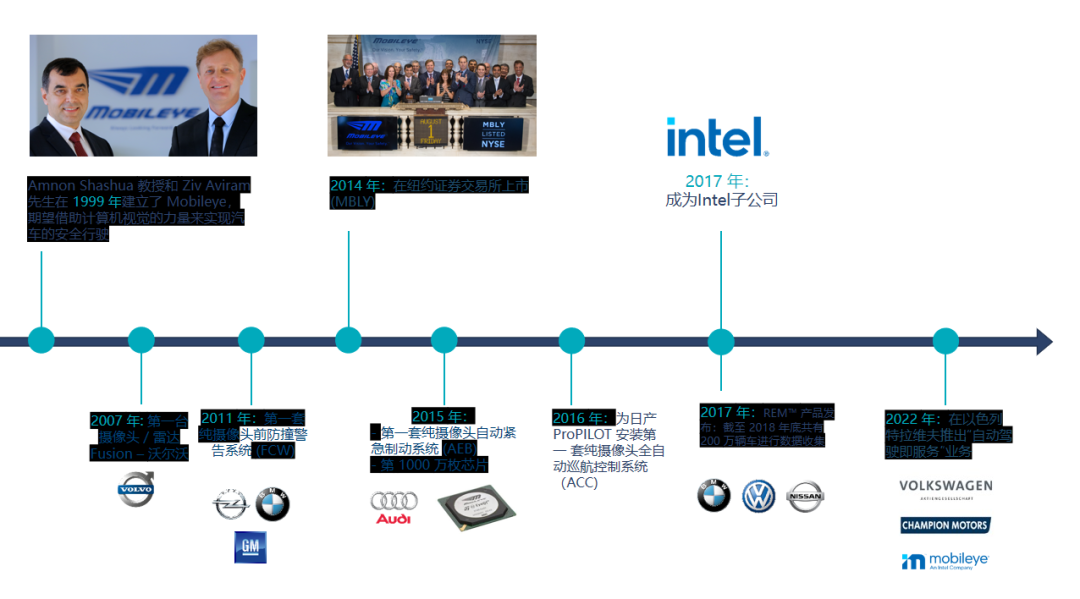 In 2014, Mobileye went public on the NYSE, becoming the largest IPO in Israel’s history. In 2017, Mobileye hit a milestone in the integration of chips and the automotive industry, as Intel acquired it for $15.3 billion, making it a benchmark and promoter in the automotive industry within the Intel family.
In 2014, Mobileye went public on the NYSE, becoming the largest IPO in Israel’s history. In 2017, Mobileye hit a milestone in the integration of chips and the automotive industry, as Intel acquired it for $15.3 billion, making it a benchmark and promoter in the automotive industry within the Intel family.
After 2020, in addition to traditional ADAS applications, Mobileye’s autonomous driving technology has also been widely deployed globally. Currently, Mobileye technology is used in L4 Robotaxi projects in cities such as Munich, New York, and Tokyo.
At this point, the EyeQ series of vision processing chip systems, which are independently developed by Mobileye, have developed to the fifth generation. The system has functions such as automatic emergency braking, lane departure warning, front vehicle distance monitoring and warning, pedestrian collision warning, front collision warning, etc. This can allow drivers to take emergency measures early on to effectively avoid traffic accidents.
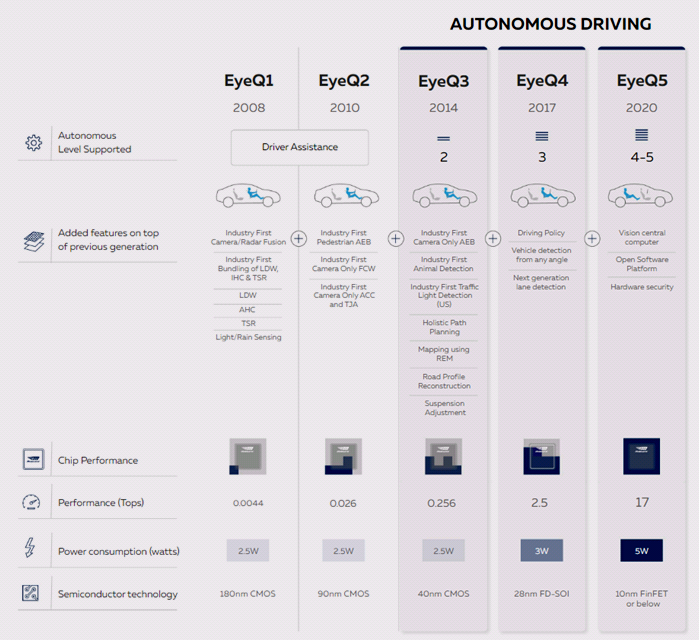
So far, Mobileye has delivered over 75 million EyeQ series chips for vehicles. Each year, 20 million new vehicles worldwide are equipped with Mobileye’s products, and more than 28 automotive manufacturers and over 300 models use Mobileye solutions.
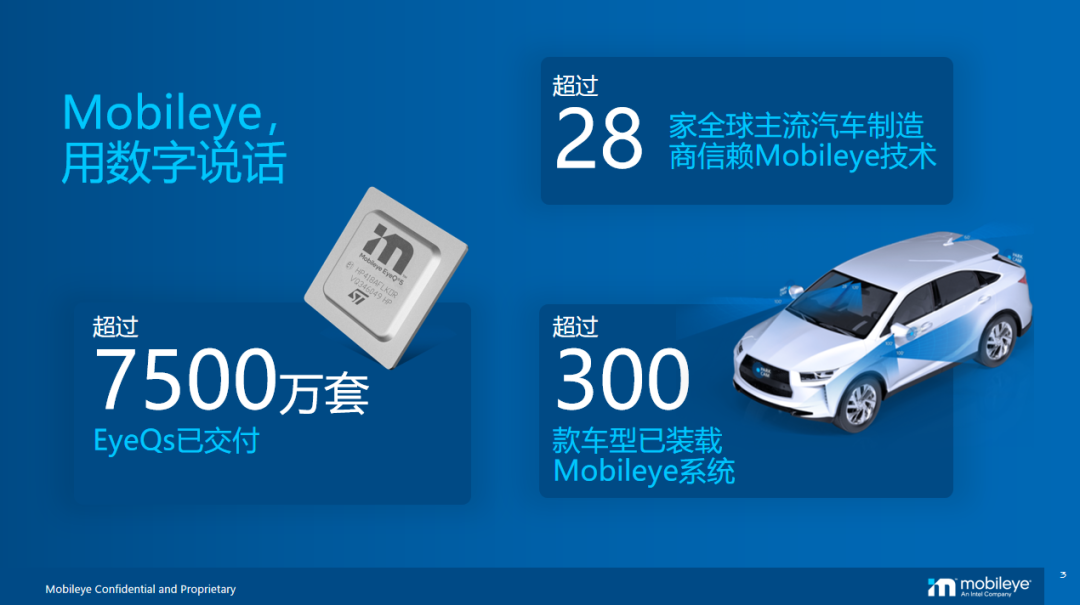
Cross-border Integration of New Business Models
The landing of intelligent connected or autonomous driving technology is a common focus of the industry. Mobileye is also transforming from an ADAS supplier in the traditional automotive supply chain to a role that provides end-to-end or cross-border integration solutions for the industry.
Tong Lifeng believes that in addition to gradual iteration in the R&D aspect, the landing of autonomous driving will focus more on segmented scenarios. Mobileye believes that there are three main scenarios: consumer-level autonomous driving vehicles, which are still mainstream, autonomous driving taxis, and autonomous driving buses and trucks. They cover To B and To C models respectively. In the To C scenario, it is necessary to have a certain period for consumers to experience, accept, and improve their understanding of new products, gradually penetrate and promote.It can be seen that Mobileye’s view is different from some manufacturers. The mainstream view is that the primary application scenario of autonomous driving is To B, and only by incorporating network connectivity or vehicle-road coordination into single-vehicle intelligence can autonomous driving enter the To C field. This also proves from another perspective that Mobileye treats To B and To C equally.
Of course, this does not prevent Mobileye from recognizing some new business models in the To B circle: the two major scenarios that can quickly land ADAS technology, intelligent network connectivity, and autonomous driving technology are Robotaxi autonomous taxis and autonomous minibusses, which are the last mile shuttle, logistics transportation, and trunk transportation.
In addition to technical reliability, the landing in the To B scenario also needs to consider whether autonomous driving technology and specific business models can really be integrated and whether the business links can be connected. Therefore, integration is an important sign for the landing of autonomous driving and intelligent network connectivity technology in the next 5 to 10 years. Whoever can combine the core technology and industry application scenarios in a high degree will be able to quickly promote the development of the industry.
For the upstream and downstream of the supply chain, including bottom-up technology suppliers such as Mobileye and even government planning departments, they may not pay much attention to the cost in the iterative process of new technologies. However, once you want to industrialize the technology, the business model becomes the most basic and important link. Everyone believes that the benefits of autonomous driving technology for industrial iteration are that Robotaxi and other vehicles using autonomous driving technology will have better path planning, more comfortable driving and riding experience, higher safety, and better sharing. Ultimately, the core is to reduce costs, increase utilization, and improve safety.
As the industry matures and integrates with segmented industries, new business models will be formed—MaaS (Mobility as a Service). Mobileye divides MaaS into five levels. The top two levels are autonomous driving systems, which are solutions provided by system providers such as Mobileye, and autonomous driving vehicles. These two levels are still in the technical iteration of research and development and automobile manufacturing. Levels 4 and 5 are more about business models in the ride-hailing or taxi field, requiring intelligent travel platforms to provide better services to users and a better experience for passengers. The middle part is the key point of integration. Whoever can combine better technology and more market-oriented application services will be able to connect the entire travel industry.
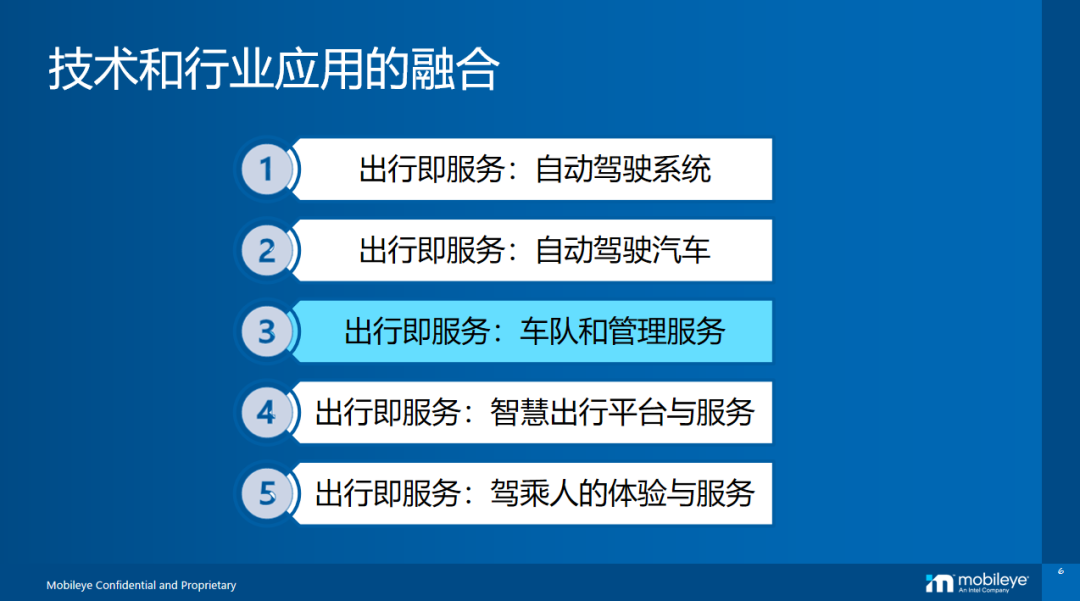
Seize the Opportunity of Travel Digitalization# Transforming the Transportation Industry with Mobileye’s Digital Solutions
According to Tong Lifeng, the digital transformation of transportation has brought us a wealth of opportunities. From a technological perspective, it requires integrated hardware and software, as well as an open platform ecosystem to drive transportation services. This involves years of accumulation of core technologies, cooperation with original equipment manufacturers (OEMs), and market-verified technologies. Mobileye’s digital solution includes AI hardware, customized software, and an open platform that can provide a more suitable travel plan for vehicle hardware and industry ecosystem partners, from providing core algorithms and chips to final products.
To promote changes in the transportation industry, Mobileye has created a platform-based AI hardware product called ME 8 (Mobileye 8 Connect). ME 8 is equipped with the latest processor EyeQ4 and an upgraded camera, and has the most advanced collision avoidance technology. It is also applicable to the data open platform of the travel industry while meeting vehicle regulation level requirements. The ME 8 product can provide multi-function ADAS on a single product, including lane departure, forward collision, pedestrian collision, vehicle speed monitoring, and speed limit recognition. It is the culmination of Mobileye’s more than 20 years of ADAS technology accumulation.
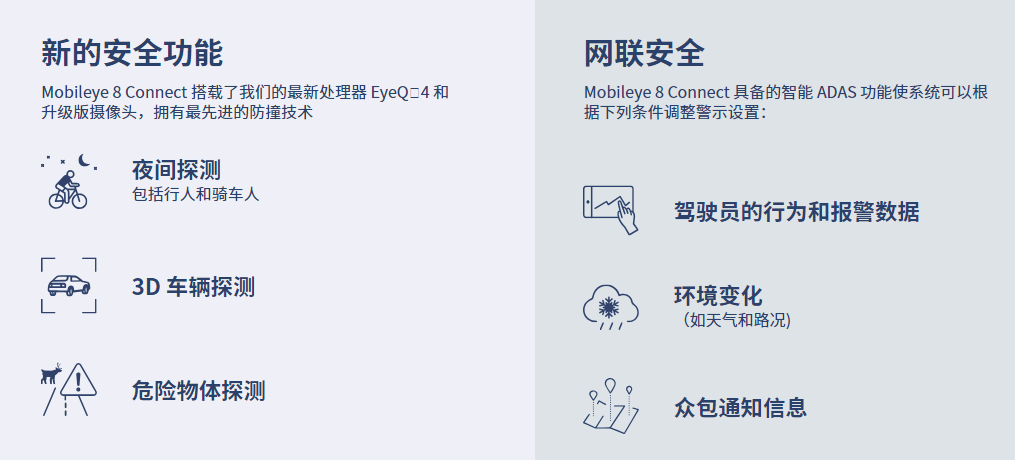
As for software updates, vehicles equipped with Mobileye will automatically receive update information through the network. The ME 8 system can receive periodic software updates to add new safety features and improve existing ones.
The ME 8 retrofit product is applicable to any type of vehicle, whether it is a passenger vehicle or a commercial vehicle that has been manufactured, and can be easily retrofitted with the ME 8 product.
Most importantly, for any fleet of vehicles, it is not necessary to purchase new vehicles with ADAS or wait for the widespread popularity of autonomous vehicles to experience the above functions.
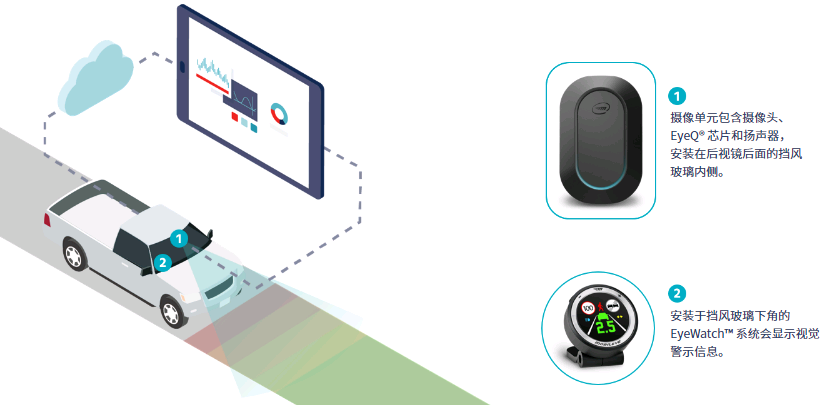
ME 8 can provide the following practical data for fleet management:
-
The driver management platform can receive analysis reports on Mobileye alarms, vehicle efficiency, and GPS data, allowing fleet managers to better understand driving behavior and operational status.
-
Provide customized alarm settings for drivers, allowing specific drivers to set alarm distance and sensitivity parameters based on their driving performance.
-
Optimize route planning by further identifying accident-prone areas, geofencing, and tracking functions.Based on the ME 8 platform, Mobileye has developed customized products for different industries and customer needs. To address the blind spot safety issues during large vehicle turning, Mobileye has developed the multi-camera vehicular solution, Smart Shield Pro, which covers all blind spot areas of large vehicles including front blind spots and turning side blind spots, using unique pedestrian recognition visual technology to identify pedestrians and cyclists, and to track them in real time. It provides drivers with advance warning of potential collisions and enables them to take preventive brake measures.
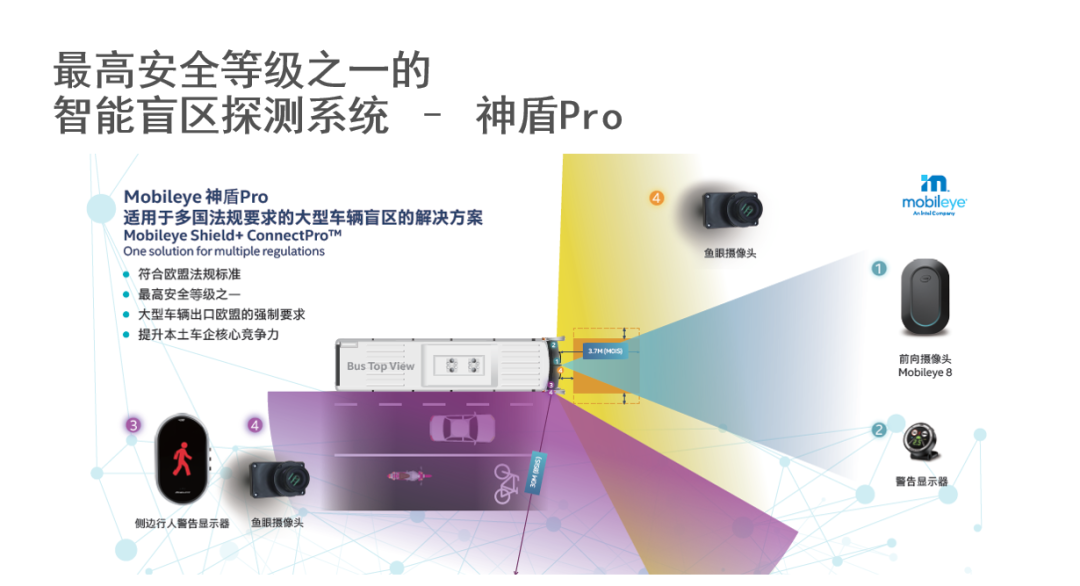
Currently, the solution mainly targets the blind spot regulations in the EU and China, and has been implemented in some OEMs and terminal fleets. From 2024, the EU will require vehicles to be equipped with corresponding blind spot solutions before leaving the factory, which will drive OEMs to expand their hardware offerings based on different scenarios.
How to cross industries?
As TONG Lifeng stated, during the landing process in segmented industries, the systematic hardware technology of Mobileye can solve industry pain points. Analysis shows that as ADAS technology becomes more prevalent, vehicle safety will inevitably improve, leading to a significant reduction in accident rates. Therefore, insurance companies, as a link in the automotive ecosystem, can benefit from this. When safety is improved and accidents are reduced, insurance claims decrease, making it more likely that technology will be applied to change the entire ecosystem, enabling more applications from different industries to participate.
A major OEM has conducted a test on the impact of driving behavior on insurance premiums, and many of the technologies they have identified are directly related to reducing accidents and lowering insurance claims. These factors provide an opportunity for cross-industry applications.
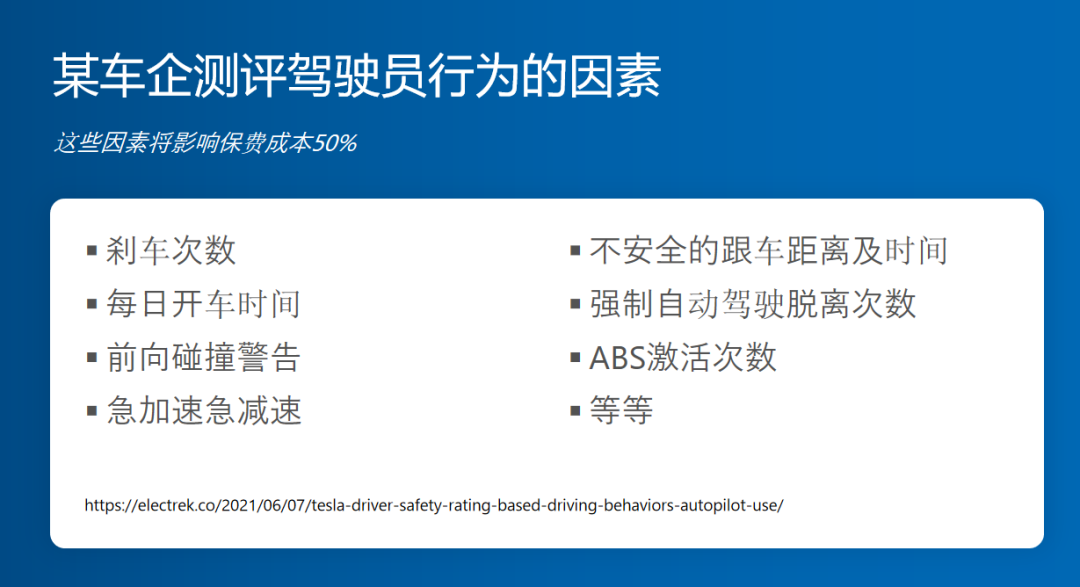
Based on this analysis, Mobileye uses its camera-related core technology to provide more data dimensions to link driving safety with insurance. These include analysis of the condition of the entire vehicle, the role of ADAS systems, the number of ABS triggers, the number of lane departures, and the vehicle’s distance-holding performance, providing useful data for insurance claims.
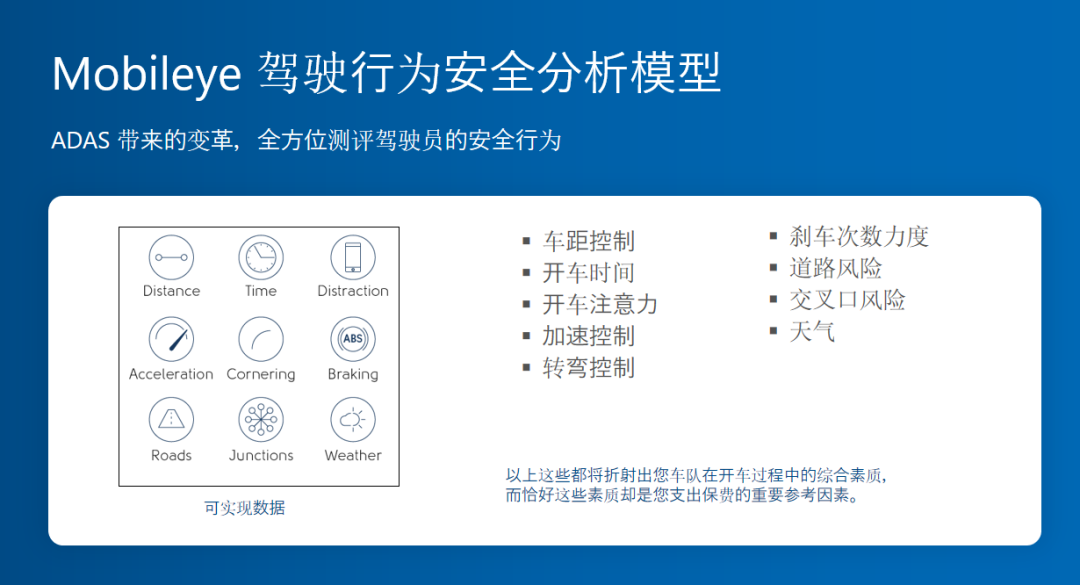 ## Now, more and more OEMs or fleets are gradually integrating autonomous driving technology with cross-sector applications. Collaborations with insurance companies are just one of the many cross-sector integrations. As the industry matures and more industries participate, more applications can be developed, which will continue to increase the scale and richness of the autonomous driving industry as well as the value of services and user experience.
## Now, more and more OEMs or fleets are gradually integrating autonomous driving technology with cross-sector applications. Collaborations with insurance companies are just one of the many cross-sector integrations. As the industry matures and more industries participate, more applications can be developed, which will continue to increase the scale and richness of the autonomous driving industry as well as the value of services and user experience.
This article is a translation by ChatGPT of a Chinese report from 42HOW. If you have any questions about it, please email bd@42how.com.
